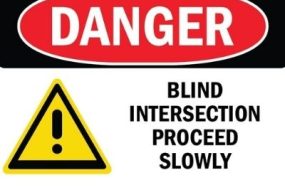
Driving on a slippery road can be very tricky, this is why you need to take extra care and precaution while you are driving on such a road.
There are a lot of different things that can cause a road to be slippery, such as rain, ice, snow, or even mud, and all of these things can make your driving experience a little more challenging and dangerous.
In normal circumstances, when the road is not slippery, the tires of your vehicle are firmly rooted to the ground, but it is not so when driving on a slippery road. Therefore, when driving on a slippery road you should?
- Leave enough space between you and the next vehicle in front of you
- Reduce your speed, and
- Take extra care when you are turning, accelerating, or when slowing down
- If you can afford to, don’t use accelerate pedal at all, especially when you’re on the ice.
What is a Slippery Road?
A slippery road is a road that has been influenced by anything that has caused the road to become wet. These things can include water, ice, mud, or snow.
When rain falls on a road that is tarred, especially on freshly tarred roads, the road tends to get very slippery and is dangerous for driving. This is why drivers are always advised to exercise more care when driving in such conditions.
Driving on a slippery road is considered driving under special conditions, as the road is not in its normal state. It is just like you driving in the night, or driving through a storm.
You have to take special care and do special things when you are driving on a slippery road, or in special conditions such as this.
What Can Make a Road Slippery?
The common element that makes a road slippery is rain. Other things that can make a road slippery are snow, during winter, ice, and then mud in the case of roads that are not tarred.
Roads are made up of tar, oil, and rubber, and when mixed with water, these parts become greasy, causing the whole layer of the road to be greasy, and when the tire meets this greasy area, it gets very slippery.
Can You Drive on a Slippery Road?
Yes, you can drive on a slippery road, but you cannot drive on a slippery road the way you drive on a road that is not slippery.
Driving on a slippery road, you are supposed to take precautions and be a lot more careful than you would be when you are driving on a road that is in perfect condition.
Does taking extra precautions mean you cannot drive on a slippery road? No, it doesn’t. you can still drive on such a road, provided that you can drive slowly and carefully.
When Driving on a Slippery Road You Should?
For those preparing for their DMV written test, when driving on a slippery road, you should increase your following distance. This is to enable you to put the car to a stop because it takes more time to stop a car on a slippery road.
Also, when driving on a slippery road, the conditions are quite different from when you are driving on a road that is in perfect condition, therefore, there are things that you have to do that you would normally not do when the road is not icy.
These things are so that you can guarantee your safety on the road, and the safety of other road users. Therefore, when driving on the road, you should:
1. Drive Slowly
This is the anthem of driving under special conditions. You have to drive slowly, as you need to be more cautious and more prepared for any unforeseen events on the road.
2. Slow Down When Turning into a Different Road
When you are about to turn to a new road, you have to slow down, this is because driving very fast while turning a corner on a slippery road can make your tires lose control on the ground and slip off.
3. Increase Your Following Distance
While driving on a slippery road, you never know what might happen, if the person in front of you is taking the same precaution as you are, this is why you have to increase your following distance.
4. Stop Farther than Usual
You should stop farther than usual when you have to stop behind a car. The same reason why you have to follow from a farther distance is why you should halt at a farther distance than you would have on a dry road. The road is slippery, and any slight mishap or shift can cause a collision.
5. Try Not to Cross Intersections and Bridges
When you know that the road is slippery, endeavor to avoid intersections and bridges. Instead, find other routes.
If you must cross these roads, you have to be a lot more careful, drive a lot slower, and maintain a lot more distance between you and the car upfront.
6. Accelerate Slowly
You shouldn’t accelerate on a slippery road if you can help it. However, if you can’t, and you have to accelerate, do so slowly, a lot slower than you accelerate on dry ground.
Disadvantages of Driving on a Slippery Road
- Bad Driving Experience: When you are driving on a slippery road, you don’t get to enjoy your driving experience because you are apprehensive and cautious most of the time.
- Dangerous: It is more dangerous to drive on a slippery road than it is to drive on a dry road. If you can afford to, don’t drive when the road is wet. Stay at home.
- Causes Fatal Accidents: Driving on a slippery road can cause terrible accidents or fatal head crashes that would never have occurred if the road was not slippery. This is why extra care is advised when driving on a icy road.
Conclusion
It is understandable that many times, we cannot avoid not driving on a slippery road. There are times that the rain starts when we are already on our journey, and we can’t help but continue the same journey on a now slippery road.
When you are driving on a slippery road, take extra precautions. Increase your following distance, increase your stopping distance, slow down completely when you want to turn, accelerate gradually, and drive twice as slow.









